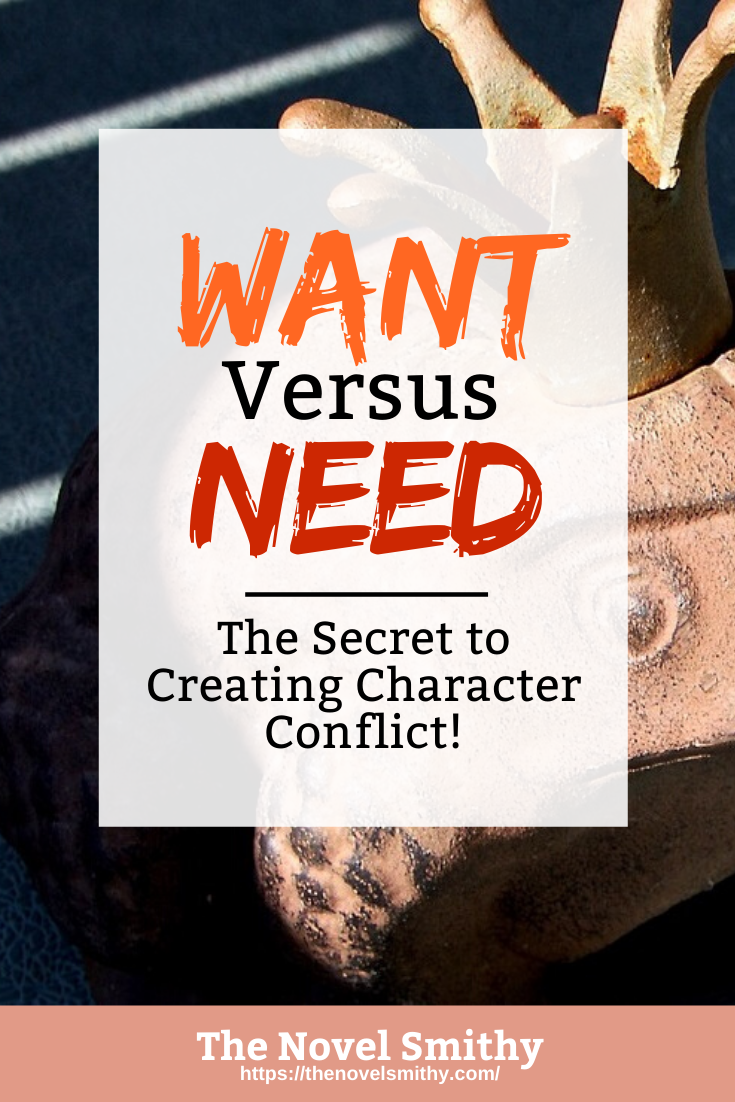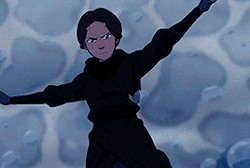Want Versus Need: the Secret to Character Conflict
What is the key to a compelling story?
If you asked ten people this exact question, you’d get at least twelve different answers, from action and drama to prose and description. However, beyond all these things is a single element that readers respond to, even if they don’t know it at first—want versus need.
You see, characters are the real drivers of a compelling story, even in more action focused genres. So, what does want versus need have to do with writing interesting characters? Well, it’s the secret to creating realistic character conflict!
Your Character’s Want versus Need
Contents
 I’m sure you’ve faced a dilemma similar to this one before—you want to eat an entire box of doughnuts, but what your body really needs is a refreshing salad. The protagonist of any good story will experience a similar pull between two desires, but their conflict will go far beyond shallow dietary habits.
I’m sure you’ve faced a dilemma similar to this one before—you want to eat an entire box of doughnuts, but what your body really needs is a refreshing salad. The protagonist of any good story will experience a similar pull between two desires, but their conflict will go far beyond shallow dietary habits.
Instead, it will affect the entire progression of their character arc.
The foundation of this conflict is their want versus need.
For instance, let’s say your hero believes that by becoming prom king he’ll gain friends, popularity, and happiness. However, in reality what he needs is to let go of his ego and embrace those lower on the popularity ladder to find true, lasting friendships.
This presents a clear internal conflict, a war between a want (popularity) and a need (acceptance). More than that, it forms the foundation for this wanna-be prom king’s involvement in your plot. He has a clear desire driving him forward, and this will motivate him to play an active role in the conflict of your story.
As a bonus, his need will also keep your audience on board, even when your prom king bullies another student in a moment of weakness. How will it do this? Well, let’s explore the concept of want versus need to see what I mean!
The Meaning of Want versus Need
To understand want versus need, you’ll first need to know what each one means:
Want: something your character desires, because they believe it’ll improve their happiness.
Need: the lesson they need to learn to overcome their inner struggle and achieve true happiness.
Just like real people, your characters will have things in their life that make them unhappy, uncomfortable, or discontent. Their want is the thing they think will free them from these problems. On the other hand, their need is to learn and grow. This is how they’ll achieve true happiness, and how they’ll overcome the conflict of your story.
Here are a few additional term to keep in mind:
Inner Struggle: This is the damaging belief or behavior your character must overcome to complete their arc. They may believe they’re weak or inferior, or they may refuse to trust anyone but themselves—whatever they struggle against, they’ll have to face this problem before their journey ends.
Wound: Your character’s wound is the deeply influential and negative past experiences that feed their inner struggle. Wounds can span from growing up under oppression to a simple episode of schoolyard bullying, depending on the scope of your story.
Truth: Your character’s truth should directly contrast their inner struggle, as it’s the lesson they’ll need to learn to achieve happiness. For example, a proud character might learn humility, while a fearful character may learn to be brave.
While this may seem like a lot of terminology, it actually forms a simple picture. Your character has some harmful belief that’s holding them back in their life. Over the course of their story, they face this struggle, come to terms with it, and hopefully learn to move past it.
So, how does want versus need play into all of this?
Distinguishing Between Want and Need
What Your Character Wants:
Your character’s want is a goal or mission they believe will make them happy.
Essentially, it’s an external solution to an internal wound.
Perhaps it’s benign like the status of prom king, or maybe it’s something more sinister like world domination. Whatever your character’s goal is, they’re seeking inner happiness through an external aim, like trying to put a band-aid on to cure the flu. It won’t work in the long run, but it’s still an important part of their character arc.
This is because your character’s want is intrinsically tied to their wound, and therefore runs deeper than an ordinary goal. Their want is defined by what they believe they need to soothe their wound, as defined above. Of course, this want is actually harmful to them, disguising their real need and creating a placebo that prevents them from meaningfully addressing their inner struggle.
![]()
As an example, in Avatar the Last Airbender, Katara wants to get revenge on the soldier who killed her mother—she’s trying to soothe the wound of watching her mother die at such a young age. Her goal is to get this much needed closure, but she goes about it through violent means.
What Your Character Needs:
Unlike their want, which is an external solution to an internal problem, your character’s need is to accept the truth they’ve learned throughout their journey.
This truth is what’ll allow them to overcome their inner struggle, and it could be anything from a simple realization to a deep spiritual awakening. By finally recognizing and accepting this truth, your character will often have to sacrifice their previous external goals as well—ultimately giving up their want—but in exchange they’ll gain healing and growth.
Returning to Katara, she realizes that her morality is more important than exacting revenge.
In a pivotal moment along her character arc, she gives up the opportunity to kill her mother’s murderer. Her need is to put her own spiritual health above her desire for revenge, to accept the value of mercy she’s learned throughout her journey, and to forgive herself for not being able to protect her family. In doing so she can finally heal, gaining the closure she previously sought through violence.
The Purpose of Character Conflict
For Your Plot:
The inner conflict a character’s want and need creates plays a major role in how they engage with your novel’s plot. Their want will define the goals they pursue early in your story, while their need will slowly push them to question those goals and their actions. Over time, their need will take center stage, determining how they overcome the plot of your novel. However, this isn’t a one way street.
In a good story, the plot reflects the protagonist’s internal conflict, while also shaping it.
Because of this, the pull between your character’s want and need should be woven into your plot, and this plot should determine how they discover their truth and embrace their need.
In the Three Act Structure, your character’s want will determine their goals during Act 1, and will be what motivated them to engage with the plot to begin with. At the Midpoint their want will finally seem attainable—however, as I’ve mentioned repeatedly, they cannot succeed without addressing their need and accepting their truth. Act 3 will see their want pushed out of reach—or proved otherwise hollow—eventually culminating in them confronting their need before or during the Climax.
For Your Reader:
Your character’s want and need will also affect how readers perceives that character.
Their want gives your character motivation, while a clearly established need gives your readers something to stick around for. Knowing your protagonist has an attainable need lets your readers continue to cheer for an otherwise flawed character, because they see their potential for positive change.
In fact, complaints of “Sue/Stu” characters, usually stem from a lack of any clear need. The character regularly succeeds in the plot, but faces no trials or challenge to their inner struggle, making their victories feel undeserved or contrived.
On the topic of trials, the example of Katara that we’ve been using so far brings up an interesting point—how far will your character go to achieve their want? Do they have a moral line they won’t cross?
Your audience needs both a clear need to look towards as well as some kind of redeeming quality in your main character. While this may not manifest as a strong sense of morality, keep this redeeming quality in mind as you’re crafting your character, and consider how much they’ll be willing to sacrifice to achieve their want.
The Bigger Picture: Character Arcs
When combined, the conflict between your characters want versus need creates a compelling character arc with clear growth from start to finish. Some of the jargon may be confusing at first, but the final result is simple—your character begins with a deep inner struggle, but by accepting the need to learn and grow, they can eventually achieve happiness.



Thank you, this was soooo helpful to me!!!!! I’ve been struggling with my character for this screenplay I’ve been writing but reading your article really helped me give my story some purpose/direction 🙂
Thanks Lewis,
I’ve had a character in mind for quite awhile but have been struggling with the want/need. This definitely helped me get it clearer. I appreciated it!
Glad to help Emme! 🙂
This was brilliant and has clarified many of the weaknesses in my novel’s first draft. Thank you so very much. I’ve now got your latest book and will be able to learn even more. You are a star ⭐️
Glad I could help Wendy!